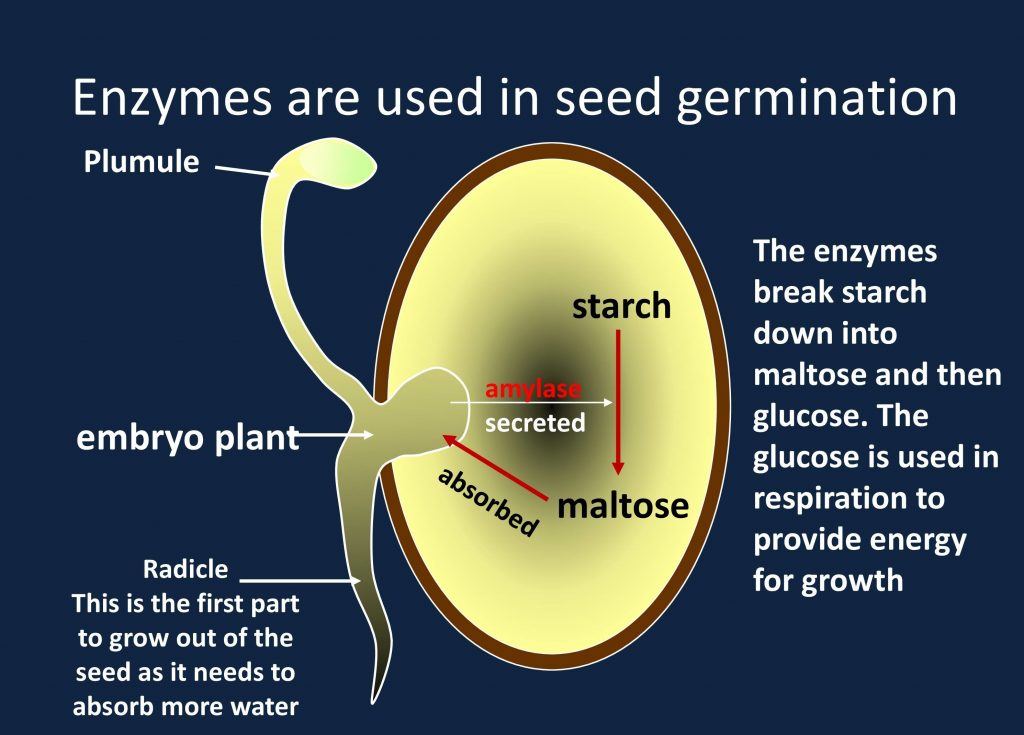Uses of Enzymes in Seed Germination

Seeds grow into plants by germinating. This involves enzymes breaking the materials stored in the seed down to be used in the growth, energy, and building of cells. The seed contains stored substances such as:
Starch
The amylase enzyme breaks the starch into maltose. It is further broken down by the maltase enzyme into glucose which is used in respiration.
Starch→Maltose→Glucose
Proteins
They are broken down into amino acids by protease enzyme and amino acids are further used in building up cells and growth.
Protein→amino acids
Fats
These are broken down into fatty acids by lipase enzyme and are used in making cell membranes.
Fats→fatty acids
In order for a seed to germinate, the conditions required are mentioned below.
- Water: to activate the enzymes.
- Oxygen: to be used for respiration.
- Temperature: provide a warm temperature for enzymes to work best.
Uses of Enzyme in Biological Washing Powder (Protease)

Washing powders contain detergents that remove stains from clothes by dissolving them in water. However, some stains are made up of insoluble substances, these cannot be removed by normal washing powders, instead, biological washing powder is used.
Enzymes are present in biological washing powder that breaks down the insoluble stain into small soluble substances, which are then dissolved in water. For example, if there is a stain of egg yolk or blood on your shirt, so no worries as an enzyme called “protease” will break down the insoluble protein into amino acids and make your shirt stainless! These are then dissolved in water and sucked away. Thus, the shirt becomes clean and stainless.
If you provide the best optimum temperature for enzymes, the stain will be removed quickly. Like presoaking give time to the enzyme to digest by adding a suitable amount of powder.
Application of Enzymes in Food Industries

Different foods are manufactured using enzymes as listed below:
Baking
In baking, both yeast and sugar are used. Enzymes are present in yeast cells that ferment sugar by anaerobic respiration. It produces carbon dioxide bubbles which cause the dough to rise.
Brewing
It is the process of making wine or beer. In this process, fermentation is involved producing alcohol and carbon dioxide that gives wine and beer their sparkle.
Cheese Making
In making cheese, an enzyme called rennin helps by clotting milk.
Juices
In fruits, such as apples and oranges, there is a substance called pectin; that holds the cells together making it hard to squeeze them. An enzyme called pectinase digests pectin making it much easier to squeeze to make the juice clear than cloudy.
Baby Foods
It is hard for newborn babies to digest high-protein foods. That is why foods like this are treated with protease to break down protein into amino acids. This makes it easier for the newborn to digest and assimilate.
Protein→amino acids
Sugar Making
Sugar-producing companies get sugar from starch using the amylase enzyme as it digests starch into maltose. For dieters, a sugar called fructose is very useful because it provides a sweeter taste than other sugars with less quantity. Additionally, fructose can be obtained by using the isomerase enzyme to convert glucose into fructose.
Starch→maltose→fructose
Meat
Protease decreases the toughness of the meat and makes it acceptable for consumers by treating its cuts.
Leather
Hairs are removed from animal skin by digesting them using protease enzymes in leather industries.
As seen on:


It is rare for me to discover something on the internet that is as entertaining and fascinating as what you have got here. Your page is lovely. Your graphics are outstanding, and, what’s more, you use sources relevant to what you’re talking about. You’re definitely one in a million. Well done!
My dear, Deniz!
Your words made my day. Thank you so much for your response, appreciation & love. It means a lot!❤️
See you again on my blog <3
Write more, that’s all I have to say. You definitely know what you’re talking about, and I really appreciate it 🙂
Thank you so much, Tamiko!
This is an interesting article, by the way. I will bookmark this article for my sister to check out later tomorrow.
Keep up the fine work.
My dear, Taylor,
Thank you so much for your response, appreciation & love. It means a lot!❤️ And I hope your sister loves my writeups as much as you do!
Stay tuned for more exciting pieces coming your way 🙂
See you again on my blog <3
Hey,
This is off-topic, but I wondered if blogs use WYSIWYG editors or if you have to code with HTML manually. I’m starting a blog soon but have no coding know-how, so I want guidance from someone with experience.
Any help would be greatly appreciated!
Hello Gregorio,
I hired an expert web designer from a Digital Business Solutions Agency Inteliract to develop my blog.
This blog is designed on WordPress and uses one of the editors, WYSIWYG (What You See Is What You Get). Moreover, HTML coding is also used wherever needed.
If you’ve any queries, feel free to ask 🙂